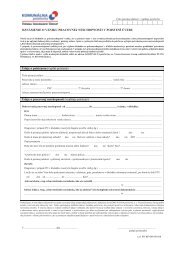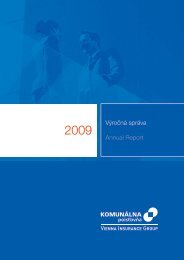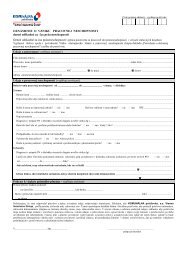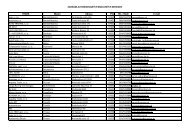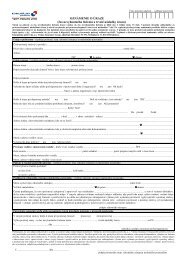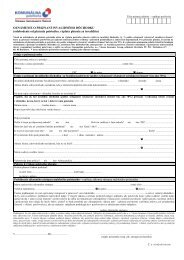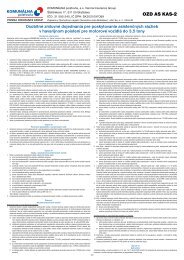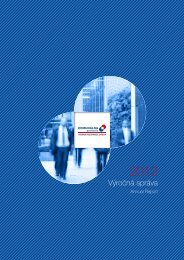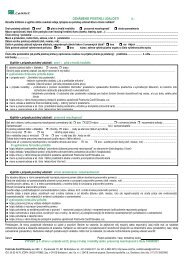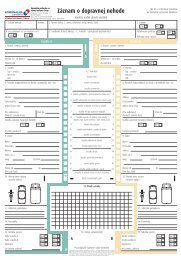kontinuita - Komunálna Poisťovňa
kontinuita - Komunálna Poisťovňa
kontinuita - Komunálna Poisťovňa
You also want an ePaper? Increase the reach of your titles
YUMPU automatically turns print PDFs into web optimized ePapers that Google loves.
NOTES TO<br />
THE FINANCIAL<br />
STATEMENTS<br />
(ii) Currency risk<br />
The Company is exposed to currency risk, mainly in respect<br />
to the Croatian kuna (HRK). In general, the Company<br />
invests into assets denominated in currencies in<br />
which the Company’s liabilities are denominated, thus<br />
mitigating the currency risk arising from the nature of<br />
its business activities. Currency risk arises mainly for<br />
securities and liabilities denominated in other currencies.<br />
If HRK weakened or strengthened by 5% against<br />
SKK, the Company is expected to suffer a loss or generate<br />
a profit of SKK 2.8 million from securities denominated<br />
in HRK.<br />
(iii) Price risk<br />
Price risk is a risk that the fair value of a financial asset<br />
will change from reasons other than changes in interest<br />
or foreign exchange rates. The Company is exposed<br />
to price risk due to investments into equity securities,<br />
with the risk being affected mainly by stock market developments.<br />
The outcome of the sensitivity analysis shows an impact<br />
on the Company’s profit and equity in case of<br />
changes in the market price of equity securities. At<br />
31 December 2008, equity securities totalled SKK<br />
457,461 thousand (2007: SKK 554,968 thousand). If<br />
their market price decreased/increased by 10%, equity<br />
would be lower/higher by SKK 45,746 thousand<br />
(2007: SKK 55,496 thousand). The impact of price risk<br />
on profit is not material for equity securities that<br />
cover investment life insurance, as the related liabilities<br />
arising from these contracts are affected in the<br />
same way.<br />
4.2.3 Credit risk<br />
The Company is exposed to credit risk, which is the risk<br />
that a counterparty will be unable to repay its debts in<br />
full when due. The main areas where the Company is<br />
exposed to the credit risk include:<br />
• amounts due from insurance contracts,<br />
• amounts due from reinsurance,<br />
• receivables from business partners,<br />
• issuers of securities, and<br />
• cash.<br />
Reinsurance is used to manage insurance risk. However,<br />
this does not reduce the Company’s liability as<br />
primary insurer. If a reinsurer fails to settle its liabilities<br />
from whatever reason, the Company remains liable<br />
for the liabilities from insurance to the<br />
policyholder. The Company reviews the credit risk of<br />
reinsurers in co-operation with its shareholder.<br />
The Company uses several tools to manage insurance<br />
receivables from the insured – one of them being the<br />
reminder process for overdue receivables, which is<br />
carried out at regular intervals.<br />
If unsuccessful, the Company takes other measures,<br />
using a several-stage collection process (intervention<br />
activities, court settlement, and seizure). In addition,<br />
the Company monitors receivables on a monthly basis<br />
by checking their payment status and ageing structure.<br />
Based on this, the default risk is assessed, and the<br />
value of impaired receivables is reduced by setting up<br />
a valuation allowance.<br />
The table below summarizes the credit risk exposure,<br />
using the rating of the Standard & Poors Agency, except<br />
for mortgage bonds issued by banks seated in<br />
Slovakia. Based on a thorough analysis of the legislative<br />
environment regulating the mortgage banking<br />
area, and considering a lower amount of risk related<br />
to mortgage bonds compared to debentures issued by<br />
banks, the parent company has decided to show an internally<br />
assigned rating at the AA level for such mortgage<br />
bonds since 2007.<br />
KONTINUITA ANNUAL REPORT 131



